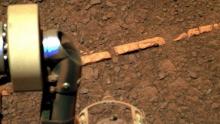The geological feature, a virtually linear stripe of light-colored rock in the ruddy Martian soil, may provide scientists with hard evidence of low-acidity liquid water at some point in Mars’ history. They believe that the formation may be phyllosilicates, minerals that are formed in the presence of a watery environment. Additionally, the water would need to be less acidic than that which formed the minerals found by the Spirit rover five years ago; water with acidity levels low enough to conceivably support life. To actually capture and examine phyllosilicates fromm the Martian surface would be an unprecedented achievement; something that Opportunity is capable of doing.
Steve Squyers, astronomer from Cornell University and lead investigator for the Mars rover missions, made this statement upon discovering The Vein.
We saw these veins as we crossed from the Meridiani plains into the Noachian terrain back in August. We've kept those in mind as a very important thing we wanted to look at, but we were so focused on getting into the Noachian and new terrain that we made that the highest priority, figuring that we would get the veins later.
The discovery is a completely new phenomenon that was, frankly, completely unexpected as well. After the silica mineral discovery by Spirit in 2006, scientists believed that although liquid water may have existed on mars surface eons ago, it probably was far to acidic to ever support life. Now, that may all have changed.
NASA is preparing another rover mission, that of Curiosity, on the 25th of this month. Curiosity is slated to land in the Gale Crater on Mars’ surface, a location that NASA chose because there was satellite imagery that seemed to indicate a high probability of phyllosilicates. However, Opportunity’s recent phyllosilicate find may upstage the new rover’s launch if the analysis of the minerals proves scientists theory of low-acidity liquid water. In either case, there seems to be overwhelming evidence that Mars landscape, at one time, may have been very hospitable to life, even if its atmosphere was not.
